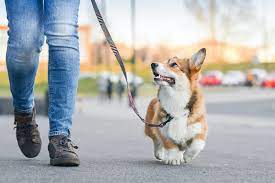How to Train a Puppy to Walk on a Leash


Having a well-trained puppy that walks calmly on a leash is a rewarding experience for both pet owners and their furry companions. Leash training is an essential skill to ensure your puppy’s safety, promote good behavior, and enhance the bond between you and your canine friend. In this article, we’ll guide you through the process of training your puppy to walk on a leash effectively and enjoyably.
Introduction
Introduce the topic of leash training and its importance in providing a safe and enjoyable walking experience for puppies.
Why Leash Training is Important for Puppies
Explain the significance of leash training, including safety benefits, better behavior control, and improved socialization opportunities.
Preparing for Leash Training
Gathering the Necessary Equipment
Provide a checklist of the essential equipment needed for leash training, such as a lightweight leash, collar or harness, and treats.
Introducing the Puppy to the Leash and Collar
Explain the importance of acclimating the puppy to wearing a collar or harness and introduce them to the concept of a leash gradually.
Establishing a Positive Association of your puppy with the Leash
Using Treats and Rewards
Explain how positive reinforcement techniques can help create a positive association with the leash and motivate the puppy during training.
Encouraging the Puppy to Approach the Leash Willingly
Provide step-by-step instructions on using treats, praise, and gentle encouragement to help the puppy associate the leash with positive experiences.
Basic Leash Training Exercises for your puppy
Teaching the Puppy to Follow Your Lead
Explain how to teach the puppy to walk beside you on a leash, focusing on commands like “heel” and using positive reinforcement techniques.
Encouraging Loose Leash Walking
Provide tips on promoting loose leash walking, including using rewards, changing directions, and practicing in low-distraction environments.
Practicing Leash Manners
Offer guidance on teaching the puppy to stop, sit, or stay on command while on a leash, fostering better control and obedience.
Dealing with Common Challenges in Training your puppy to walk on leash
Pulling on the Leash
Provide strategies for managing and correcting pulling behavior, such as stopping when the puppy pulls and using positive reinforcement for desired behavior.
Reactivity Towards Other Dogs or Distractions
Offer techniques to help the puppy stay calm and focused when encountering other dogs, distractions, or triggers during walks.
Consistency and Persistence in Training
Highlight the importance of consistency, patience, and regular practice to achieve successful leash training outcomes.
Safety Considerations During Leash Training
Address safety concerns related to leash training, such as choosing appropriate walking areas, avoiding potential hazards, and using reflective gear for visibility.
Gradually Increasing the Difficulty Level
Advise on gradually introducing more challenging environments, distractions, or longer walks as the puppy progresses in their leash training.
See also: How to Make a DIY Hands-Free Dog Leash
Additional Tips for Successful puppy on Leash Training
Provide additional helpful tips, such as maintaining a positive attitude, using the puppy’s energy wisely, and varying the walking routes for mental stimulation.
Conclusion
Summarize the main points covered in the article, emphasizing the benefits of leash training and the importance of patience, consistency, and positive reinforcement.
FAQs about How to train a puppy to walk on leash
How long does it take to train a puppy to walk on a leash?
The time it takes to train a puppy to walk on a leash can vary depending on the individual dog and consistency in training. On average, it can take several weeks to a few months of regular practice for a puppy to become comfortable and proficient in walking on a leash.
Can I use a harness instead of a collar for leash training?
Yes, using a harness can be a suitable option for leash training, especially for puppies with delicate necks or breeds prone to respiratory issues. A harness distributes the pressure more evenly across the puppy’s body, reducing strain on the neck and throat. It’s important to choose a well-fitted harness and introduce it gradually to ensure the puppy feels comfortable and secure.
What should I do if my puppy refuses to walk on a leash?
If your puppy is reluctant to walk on a leash, it’s essential to be patient and understanding. Start by creating a positive association with the leash through treats, rewards, and praise. Gradually introduce the leash in short sessions, allowing the puppy to explore and get used to the feeling. If the resistance continues, consult a professional dog trainer for guidance and personalized advice.
Should I hire a professional trainer for leash training?
Hiring a professional dog trainer can be beneficial, especially if you’re facing difficulties in leash training or if you prefer expert guidance. Trainers can assess your puppy’s specific needs, provide personalized training plans, and address any behavioral issues that may arise during leash training. They can also offer valuable tips and techniques to enhance your training experience.
See also: Is border collie a good off-leash dog
Can I use a retractable leash for my puppy?
It’s generally recommended to avoid using retractable leashes for puppy leash training. Retractable leashes allow the dog more freedom to roam, which can lead to less control and potential safety risks, especially during training stages. It’s best to opt for a standard leash with a fixed length, providing better control and guidance as you teach your puppy to walk on a leash.




